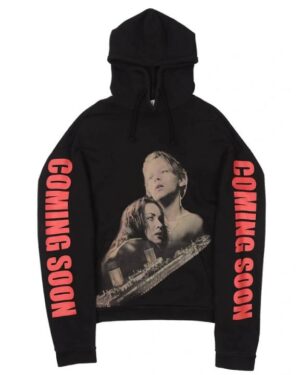
Vetements The Brand That Blurred the Lines Between Streetwear and Luxury
Vetements is a name that has rapidly become synonymous with cutting-edge streetwear and avant-garde high fashion. Founded in 2014 by Georgian designer Demna Gvasalia, the brand has redefined the traditional boundaries between luxury fashion and everyday street style, creating a phenomenon that’s influenced both haute couture and casual wear in equal measure.
The Birth of Vetements
Vetements which translates to “clothing” in French, was conceived as a collective of like-minded designers and creatives. While Demna Gvasalia is the figurehead and creative force behind the brand, Vetements started as a collaborative effort, drawing from the talents of several emerging designers. The brand was officially launched in Paris, but its core identity and influence can be traced back to Gvasalia’s upbringing in Georgia and his previous work at major fashion houses like Maison Margiela (as creative director) and Balenciaga (as creative director).
The founding vision for Vetements was simple: to question the norms of fashion, challenge luxury’s traditional exclusivity, and produce garments that merge the high and low ends of the fashion spectrum. It’s a vision that has resonated with fashion-forward thinkers, streetwear enthusiasts, and the broader cultural zeitgeist.
The Aesthetic: Disrupting Fashion Norms
From the start, Vetements distinguished itself with its unique aesthetic—one that refuses to be confined by established fashion conventions. The brand blends streetwear with high-end tailoring, often using bold, oversized silhouettes, distressed materials, and ironic references to everyday life.
Key elements of Vetements’ aesthetic:
- Oversized and Deconstructed Fits: Vetements is known for creating garments that feel intentionally ill-fitting. From oversized jackets and baggy pants to oversized hoodies, the brand pushes the boundaries of traditional tailoring. This rebellious approach to fit challenges the idealized and often restrictive notions of fashion, opting instead for comfort and freedom of movement.
- Streetwear Meets High Fashion: Vetements has become famous for bringing streetwear into the luxury fold. Collaborations with fast-fashion giants like H&M (in 2016) blurred the lines even further between luxury and accessibility. The result: a democratization of high fashion, where luxury becomes more wearable and, in some cases, affordable.
- Graphic Logos and Branding: Like many streetwear brands, Vetements often uses bold graphic prints and logos. However, its use of logos is often subversive, reflecting irony or playful mockery of fashion industry norms. For example, Vetements has released items featuring logos from fast food chains, mundane product names, or even supermarket logos, a deliberate choice to poke fun at the concept of “branding.”
- Subversion of Traditional Fashion Codes: The brand often incorporates elements that are traditionally seen as “ugly” or “wrong,” such as deliberately mismatched shoes, pants that fall just above the ankle, or oversized coats that look almost like they’ve been borrowed from someone else’s wardrobe. This irreverence and disregard for “idealized beauty” have made Vetements a brand for the fashion outsider.
High-Profile Collaborations and Cultural Impact
Vetements Hoodie quickly became a cultural touchstone not only because of its bold designs but also due to its unique collaborations and marketing strategies. The brand’s collaborations have been groundbreaking, spanning a wide range of unexpected partnerships.
Collaborations:
- Reebok: Vetements has worked with Reebok to create high-end, fashion-forward takes on classic athletic footwear, transforming sneakers into statement pieces.
- Levi’s: The brand famously collaborated with Levi’s to create deconstructed denim jackets and jeans, offering a reimagined version of American workwear with a high-fashion twist.
- Dr. Martens: Vetements reworked the iconic Dr. Martens boot, adding its signature oversized, rugged aesthetic to the footwear, making the shoes a luxury streetwear item.
These collaborations, combined with Gvasalia’s ability to blend seemingly disparate influences, have allowed Vetements to tap into a wide variety of cultural conversations, from fashion to music, art, and social commentary.
The Vetements Effect on Fashion
Vetements has arguably played a major role in the rise of the “democratization of fashion”, where the lines between luxury and mass-market are increasingly blurred. The brand’s influence can be seen in how other major fashion houses have begun to incorporate streetwear elements, oversized fits, and even the use of logos in their collections. Vetements made it clear that high fashion no longer needed to exist on a pedestal, isolated from the daily realities of ordinary life. Instead, it could—and perhaps should—be something that reflects and engages with the world in a more authentic, relatable way.
Demna Gvasalia’s transition from Vetements to Balenciaga has further solidified his position as one of the most influential figures in contemporary fashion. Many of the concepts and visual language used at Vetements were seamlessly integrated into his work at Balenciaga, which continued the brand’s focus on subversion, oversized silhouettes, and the combination of luxury with utilitarian elements.
Vetements Today: A Cultural Icon
In recent years, Vetements has faced both triumphs and challenges. After its meteoric rise, the brand has had to navigate a rapidly changing fashion landscape, marked by the rise of new cultural movements, shifting consumer preferences, and the increasing prominence of digital fashion.
While some critics argue that the brand has become less influential, the cultural impact of Vetements remains undeniable. The brand is not just a clothing label—it’s a symbol of how fashion can be a reflection of cultural change. Its blending of high fashion with streetwear, punk aesthetics with luxury, and the constant questioning of what fashion “should” be, has made Vetements a permanent fixture in the fashion lexicon.
Conclusion: The Future of Vetements
As fashion continues to evolve and shift, the legacy of Vetements—whether as a standalone brand or through Gvasalia’s influence in other avenues—remains one of disruption, experimentation, and creative freedom. Vetements proved that fashion could break free from tradition, that high-end clothing could be both a statement and a functional part of daily life, and that subversion could be just as powerful as convention.
Whether the brand continues to push boundaries with each new collection or finds itself in a quieter, more reflective phase, one thing is clear: Vetements changed the conversation around fashion, and its influence will likely continue to shape the future of both streetwear and high fashion for years to come.




Leave Your Comment